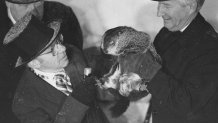In a tradition synonymous with early February in America, a furry forecaster in Pennsylvania tells chilly people all over the nation if spring will come early, or if they’ll have to endure six more weeks of biting temperatures.
It's Groundhog Day.
Some people may Punxsutawney Phil’s shadow as a weather-forecasting truth while others just love what can seem like a silly tradition.
But why do we check in on the shadow of a groundhog in the deep of winter each year?
Get Connecticut local news, weather forecasts and entertainment stories to your inbox. Sign up for NBC Connecticut newsletters.
Here's what to know about Groundhog Day:
What happens on Groundhog Day?
On Feb. 2 each year, members of the Punxsutawney Groundhog Club, established in 1887, make their way to Pennsylvania’s Gobbler’s Knob, a rural area a couple of miles outside of the town of Punxsutawney, from which the celebrated rodent gets its name.
U.S. & World
There, they wait for groundhog Punxsutawney Phil to come out of hibernation.
Upon his emergence, everyone waits with bated breath to see if his shadow appears. If it does, legend has it there will be six more weeks of winter. But, if Phil is shadow-free, spring will come early.
How did Groundhog Day start?
According to the club, the holiday began as a part of the Christian celebration of Candlemas Day in Europe, which was first observed in A.D. 350. To celebrate, Christians took their candles to church to have them blessed as a way to bring good fortune to their household for the remaining winter.
The holiday’s focus evolved from its candle-centric ways to animal-centric ways when Germany joined in and a hedgehog was introduced.
“If, according to German lore, the hedgehog saw his shadow on Candlemas Day there would be a ‘Second Winter’ or 6 more weeks of bad weather,” according to the club.
As German settlers journeyed to the U.S., specifically to Pennsylvania, they found far fewer hedgehogs existed, so they went for the next best hibernating option: a groundhog.

(Photo via Getty Images)
When was the first Groundhog Day in Punxsutawney?
The first official celebration in Punxsutawney happened in 1887 with the first official trek to Gobbler’s Knob, according to the Punxsutawney Groundhog Club. There may have been earlier similar celebrations in the area.
“Each year since then has seen a steady increase in participation of the celebration from people all over the world,” according to the club’s website.
Following the popularity of the 1993 Bill Murray movie "Groundhog Day," the event increased in popularity. Thousands of people have turned out for recent events.
So, who is Punxsutawney Phil?
Well, let's just say the club has probably taken some liberties with its story of Phil.
The famous groundhog’s namesake comes from an unspecified "King Philip." He also has a wife, named Phyliss.
How many Punxsutawney Phils have there been?
That, too, is shrouded in lore. According to the Groundhog Club, Phil lives forever.
According to the club lore, there has only ever been one Punxsutawney Phil. He credits his longevity to a secret “elixir of life.”
And Phyliss?
“She doesn’t receive the Elixir of Life so she will not live forever like Phil,” the club says in its website’s section on Phil.
According to experts, groundhogs in the wild can live up to six years, but two-to-three years is the average. In captivity, groundhogs have reportedly lived up to 14 years.
So it's a safe bet the Phil of 2024 is not the same Phil of 1887.

(Photo by Spencer Platt/Newsmakers)
Where does Phil live full-time?
As for where Phil lives full-time, he spends most of the year in a man-made zoo that is climate-controlled and light-regulated. The zoo is connected to the town’s town park and library.
Because of this environment, Phil does not actually go into full hibernation each year. Unlike outdoor groundhogs who receive signals to hibernate based on a change in daylight hours, Phil’s lights and temperature are consistent year-round.
“In the winter months, he does slow down, eats less, and sleeps more, but he doesn’t hibernate,” the club’s site says.
His weight fluctuates throughout the year due to his change in appetite and exercise. During the summer months, he is much heavier at about 17 pounds and during the winter months he is lighter, only about 11 pounds.
One thing does remain the same for Phil – his favorite foods, which include kale, sweet potatoes, corn on the cob and bananas.
Visitors to Phil's Burrow can see the celeb groundhog -- and others of his groundhog friends -- year-round through a window from outside their burrow.
How accurate is Phil at predicting the weather?
Loyalists will tell you Phil has a perfect record, but weather experts would beg to differ.
According to a division of the National Oceanic and Atmospheric Administration, Phil has gotten it right 40% of the time over the past 10 years.



